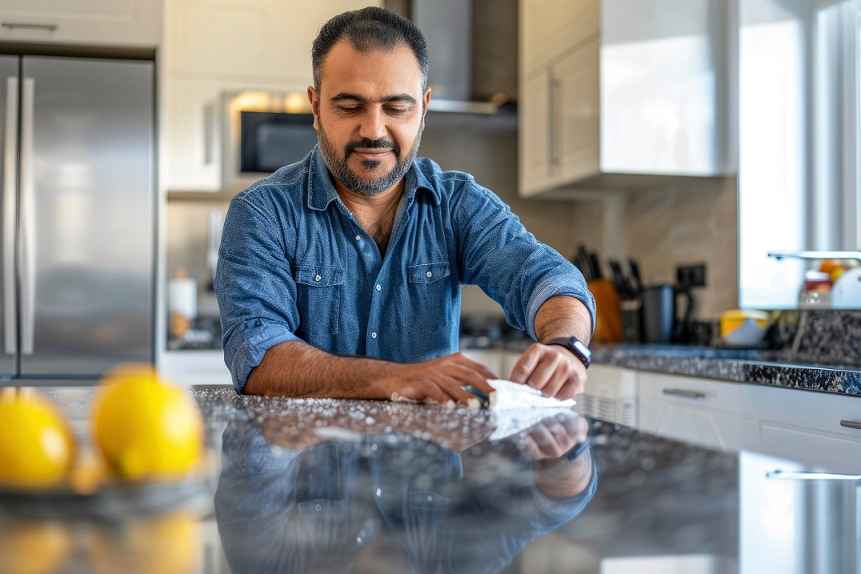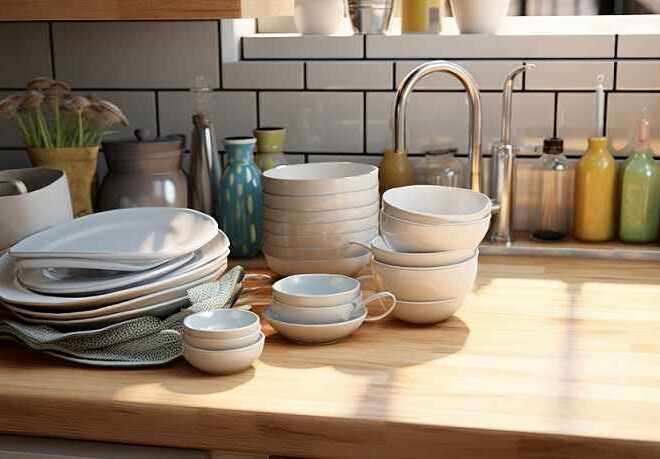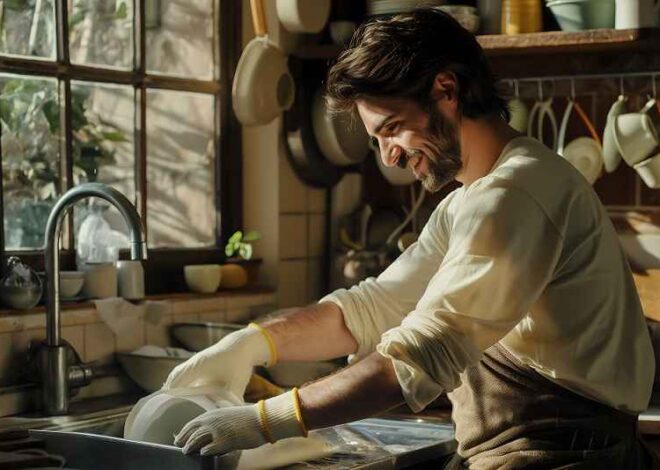
The Pros and Cons of DIY Kitchen Backsplash Installation
Are you tired of staring at those boring, bare walls in your kitchen? Dreaming of a vibrant backsplash that transforms your cooking space into the heart of your home? The good news is that installing a DIY kitchen backsplash can be both an empowering and rewarding project! However, before you grab your tools and dive headfirst into tile or peel-and-stick options, it’s essential to weigh the pros and cons. In this blog post, we’ll explore everything from cost savings and creative freedom to the potential pitfalls that could turn your weekend project into a DIY disaster. Whether you’re a seasoned handyman or just starting out on your home improvement journey, we’ve got all the insights you need to make an informed decision. Let’s get started on transforming not just your walls but also how you think about DIY projects!
Introduction to DIY Kitchen Backsplash Installation
Are you ready to transform your kitchen into a stylish culinary haven? One of the most impactful upgrades you can make is installing a new backsplash. While it might seem like a daunting task, many homeowners are turning to DIY solutions for their kitchen backsplash installation. The allure of doing it yourself is strong: saving money, customizing your space, and the satisfaction that comes from completing a project with your own hands. But before you grab those tiles and adhesive, it’s essential to weigh the pros and cons of taking on this home improvement challenge. Let’s dive into what makes DIY kitchen backsplash installation appealing—and where it might fall short.
Pros of DIY Kitchen Backsplash Installation
Choosing to install your own kitchen backsplash can be a smart decision for several reasons. First and foremost, it’s a cost-effective option. You save on labor costs by taking on the project yourself.
Another significant advantage is the opportunity for personalized design. You can select materials, colors, and patterns that reflect your style without being limited by someone else’s vision.
Furthermore, completing this project on your own brings an incredible sense of accomplishment. The pride you feel when stepping back to admire your handiwork adds a unique touch to your home.
Not only do you enhance your space aesthetically, but you also gain valuable skills in the process. Each step taken makes future projects less daunting and more achievable!
-
Cost-effective option
One of the most appealing aspects of DIY kitchen backsplash installation is its cost-effectiveness. Hiring a professional can quickly inflate your budget, often due to labor costs and additional fees for materials.
By choosing to tackle this project yourself, you retain control over expenses. You can shop around for affordable tiles, opting for sales or clearance items that fit your style without breaking the bank.
Moreover, many DIY-friendly materials are available at reasonable prices. From ceramic to glass options, you’ll find plenty that suit both your taste and wallet.
The savings add up when you consider how little effort it takes to plan and execute a beautiful backsplash on your own terms. Embracing creativity in design allows you not only to save money but also express your unique personality throughout the kitchen space.
-
Personalized design
A DIY kitchen backsplash installation offers a unique opportunity to express your personal style. You have complete control over the materials, colors, and patterns you choose. Whether you prefer bold mosaics or subtle subway tiles, every decision reflects your taste.
This freedom means that no two backsplashes need to look alike. You can incorporate elements that resonate with your home’s aesthetic or even create a theme that ties into other spaces in your house.
Mixing textures like glass and stone can add depth and interest to the design. Perhaps you’d like to include an artistic mural or custom artwork—something pre-made options simply cannot provide.
The result is not just a functional piece of décor but also an integral part of your kitchen’s identity. Your creativity leads the project, making it truly one-of-a-kind while enhancing the overall ambiance of your cooking space.
-
Sense of accomplishment and pride
Taking on a DIY kitchen backsplash installation can be incredibly rewarding. When you step back and admire your handiwork, the sense of accomplishment is palpable. You look at those tiles that you meticulously placed and realize they are a reflection of your effort.
Each piece tells a story—of patience, creativity, and hard work. That feeling doesn’t just come from the finished product; it stems from every decision along the way: selecting materials, laying out patterns, and overcoming challenges.
In an age where convenience often overshadows craftsmanship, doing it yourself fosters pride in what you’ve created. It’s not just about aesthetics; it’s about investing in your space with personal touches only you could envision. There’s nothing quite like knowing you transformed your kitchen with your own hands!
Cons of DIY Kitchen Backsplash Installation
DIY kitchen backsplash installation can seem appealing, but it comes with its own set of challenges. One major drawback is the time investment required. What might appear as a simple weekend project could easily stretch into several days or even weeks, especially if you’re new to home improvement tasks.
Mistakes are another real concern. An amateur approach often leads to misalignment and uneven tiles. These errors can be frustrating and costly to fix after the fact.
Additionally, without proper tools and skills, achieving a polished look becomes difficult. Not everyone has access to professional-grade tools or the expertise needed for precise cutting and measuring.
These factors can turn an exciting project into a stressful experience quickly when expectations don’t align with reality. It’s essential to weigh these potential pitfalls before deciding on a DIY path for your kitchen backsplash installation.
-
Time-consuming process
Installing a kitchen backsplash can be more than just a weekend project. It often demands significant time and effort, especially if you’re new to DIY tasks.
From picking out materials to preparing the wall surface, each step requires careful attention. You might find yourself spending hours just measuring and cutting tiles to fit your space perfectly.
The installation itself can stretch into days, particularly for intricate designs or larger areas. Patience is key here; rushing through could lead to mistakes that require more time for corrections later on.
Then there’s drying time for adhesives and grout, which adds even more wait time before you can fully enjoy your handiwork. If you have a busy schedule or other commitments, this lengthy process may not align well with your lifestyle.
-
Potential for mistakes and errors
DIY kitchen backsplash installation can be a rewarding project, but it comes with its challenges. One significant drawback is the potential for mistakes and errors during the process.
Even minor miscalculations can lead to uneven tiles or gaps that disrupt the overall aesthetic. A small slip in measuring could mean wasted materials and extra costs.
Grouting mishaps might result in unsightly lines or an imperfect finish, which can be hard to rectify once dried. Removing improperly placed tiles often damages the wall underneath, leading to more repairs than anticipated.
Additionally, improper alignment of tiles not only affects appearance but may also impact functionality if they interfere with appliances or cabinets. Errors like these can turn a simple DIY task into a frustrating ordeal that consumes time and resources better spent elsewhere.
-
Requires tools and skills
DIY kitchen backsplash installation isn’t just about slapping on some tiles. It requires a good set of tools and a bit of know-how.
First, you’ll need essential equipment like tile cutters, trowels, and spacers. These aren’t typically found in every household toolbox. Investing in quality tools can make a significant difference to the final outcome.
Then there’s the skill factor. Understanding how to measure accurately is crucial. One wrong cut can lead to wasted materials or uneven layouts.
Knowledge about adhesive types, grout application, and sealing techniques is also vital. Each step has its nuances that can affect durability and appearance.
If you’re not comfortable with these skills or don’t have the time to learn them, it might feel overwhelming rather than rewarding. The learning curve could turn this project from an exciting opportunity into a stressful challenge.
Tips for Successful DIY Kitchen Backsplash Installation
Choosing the right materials is crucial. Consider your kitchen’s style and your personal taste. Whether you prefer tiles, glass, or metal, ensure they complement your decor.
Preparation makes a difference. Clear out the area where you’ll work. Clean surfaces thoroughly to help adhesives bond better.
Planning can prevent headaches later on. Measure twice before cutting any material. Sketch out your design to visualize how it will look once installed.
Follow a step-by-step guide for each phase of installation. Start from the center for balance when laying tiles or panels, and use spacers for even gaps.
Don’t rush through the process; take breaks if needed to maintain focus and precision. A little patience goes a long way in achieving that professional finish you desire!
-
Choosing the right materials and tools
Choosing the right materials is crucial for a successful kitchen backsplash installation. Consider options like ceramic, glass, or even natural stone. Each material offers a unique look and feel to your kitchen.
Think about durability too. Some materials can withstand heat and moisture better than others, which is essential in cooking spaces. Make sure you pick something that aligns with your lifestyle.
Tools are just as important as the materials themselves. Basic tools like tile cutters, trowels, and spacers should be on your list. Don’t forget adhesive! A quality thin-set mortar or mastic ensures everything sticks well over time.
If you’re new to DIY projects, consider investing in some instructional videos or books specific to backsplash installations. Familiarizing yourself with techniques will make the process smoother and more enjoyable.
-
Proper preparation and planning
Proper preparation and planning are crucial for a successful kitchen backsplash installation. Start by measuring your space accurately. Knowing the dimensions helps avoid costly mistakes.
Next, gather all necessary materials and tools beforehand. This includes tiles, adhesive, grout, a trowel, and spacers. Having everything on hand saves you from last-minute trips to the store.
Consider creating a layout before applying anything to the walls. Lay out your tiles on the floor or countertop first to visualize how they’ll fit together.
Another vital step is surface preparation. Ensure that your wall is clean and dry. Remove any old tiles or grease stains as these can affect adhesion.
Lastly, take time to plan your design pattern carefully. Whether it’s classic subway tiles or an intricate mosaic, knowing what you want will guide every step of the process.
-
Step-by-step installation guide
Start by gathering your materials. You’ll need tiles, adhesive, a trowel, and grout. Don’t forget safety gear like gloves and goggles.
Next, measure the area where you’ll install the backsplash. Use a level to ensure straight lines for an even finish.
Once you have your measurements, cut the tiles as needed with a tile cutter or wet saw. Lay out the tiles without adhesive first to visualize the pattern.
Apply adhesive to the wall using your trowel. Press each tile firmly into place, leaving small gaps for grout in between.
After letting it set according to product instructions, mix and apply grout over those gaps carefully. Clean off any excess while it’s still wet.
Allow everything to cure fully before putting back any kitchen items or appliances near your new backsplash!
Alternatives to DIY Kitchen Backsplash Installation
If DIY isn’t your style, consider hiring a professional contractor. This option guarantees quality workmanship and saves you time. Experts bring experience and knowledge that can make the project smoother.
Another alternative is using adhesive backsplash tiles or peel-and-stick options. These products are designed for easy application and often come in stylish designs. They’re perfect for someone looking to enhance their kitchen without the hassle of traditional installation methods.
Both choices provide different benefits, whether it’s peace of mind from skilled labor or simplicity in self-adhesive materials. Exploring these alternatives can lead you to a beautiful new backsplash with less stress.
-
Hiring a professional contractor
When considering kitchen backsplash installation, hiring a professional contractor can be an appealing option. Professionals bring experience and expertise that often translate into stunning results. They understand the nuances of different materials, ensuring proper application and durability.
Navigating complex designs or challenging layouts is where their skills shine. A contractor can foresee potential issues before they arise, saving you from costly mistakes down the line.
While this route comes with a higher price tag than DIY methods, it alleviates stress and time constraints. You won’t have to worry about sourcing tools or dealing with cleanup afterward.
Moreover, many professionals offer warranties on their work, providing peace of mind for years to come. If you’re someone who values quality over cost savings, enlisting expert help might just be the right path for your kitchen makeover.
-
Using adhesive backsplash tiles or peel-and-stick options
Adhesive backsplash tiles and peel-and-stick options have become popular alternatives for those looking to upgrade their kitchen without the hassle of traditional installation. These products offer a quick solution that can transform your space in no time.
Installation is straightforward. Simply peel off the backing and stick them onto a clean, dry surface. This ease makes it accessible for anyone, even if you lack handyman skills.
The variety available is impressive too. From classic subway tile designs to trendy mosaic patterns, there’s something to match every style preference.
Maintenance is generally low as well; most surfaces only require a simple wipe down with mild soap and water. Plus, if you ever decide to change your look again, removing them is just as easy.
These options combine convenience with aesthetics while offering flexibility for any kitchen design project.
Real Life Experiences: Success Stories and Lessons Learned
Many DIY enthusiasts have transformed their kitchens with stunning backsplashes. One homeowner shared how they chose vibrant mosaic tiles. The result was a lively kitchen that reflected their personality.
Another story involves a couple who tackled the project together. They documented every step, turning it into a fun bonding experience. Their teamwork not only led to an eye-catching backsplash but also strengthened their relationship.
However, not all stories are perfect success tales. A novice installer learned the hard way about uneven grout lines after rushing through the process. It became a valuable lesson in patience and precision.
These real-life experiences highlight both triumphs and trials in kitchen backsplash installation. Every journey offers insights that can make future projects smoother and more enjoyable.
Conclusion:
When considering kitchen backsplash installation, the decision between DIY and hiring a professional can greatly influence your project. If you enjoy hands-on tasks, have an eye for design, and are willing to invest time in learning new skills, a DIY approach may be rewarding. It offers financial savings and allows for creative customization that truly reflects your style.
However, it’s essential to weigh the potential challenges. Time constraints, the possibility of errors during installation, and the need for specific tools can make this task more daunting than it appears at first glance.
Ultimately, whether you choose to embark on a DIY kitchen backsplash installation or seek assistance from professionals depends on your confidence level and resources available. Each option has its unique set of advantages and drawbacks that should align with your goals for both functionality and aesthetics in your home space.


